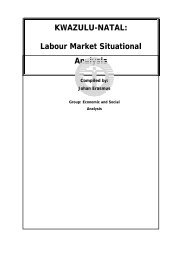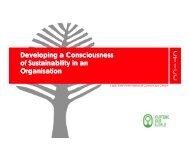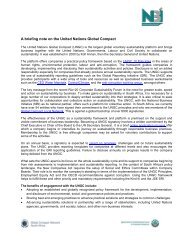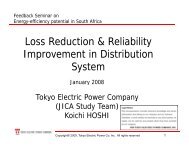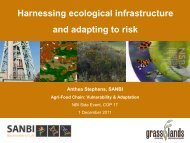Sustainable Forest Finance Toolkit - PwC
Sustainable Forest Finance Toolkit - PwC
Sustainable Forest Finance Toolkit - PwC
- No tags were found...
Create successful ePaper yourself
Turn your PDF publications into a flip-book with our unique Google optimized e-Paper software.
Planted forests briefing note 3 of 6New Application HOMELocation-specific risksSpatial considerations vary according to the nature of thelandscape. If the landscape has been in a highly modifiedstate for a long period of time (i.e. not natural forest), as inGuangxi Province, China, the focus of conservation is likelyto be at the stand level. Consequently, environmentalprotection-orientated activities will focus on managementpractices such as the protection of riparian zones (areasimmediately adjacent to rivers, which are generally rich inbiodiversity), prevention of soil erosion, and maintenance ofsite productivity. The necessity to identify areas of high(biodiversity) conservation value is not likely to be asignificant concern, with the exception of areas important formigratory species. However, IMPF establishment andmanagement could contribute to site rehabilitation andlandscape restoration, as part of an integrated programmedirected at these goals.If the landscape has been highly modified within the past fewdecades, such as in Espirito Santo and Bahia States, Brazil,there is a strong imperative for the immediate application ofthe landscape approach to optimise the value of remnantareas important for conservation. In these particularexamples, remnant native forests have legislative protection,and thus IMPF expansion is not occurring at the expense ofnative forests. In other cases where legislative protectionmay not be as strong, IMPF development should be guidedby the landscape approach and protect all areas of highconservation value.If IMPFs are being established in a frontier (or recently postfrontier)landscape (i.e. recently cleared natural or secondaryforest) such as in Riau Province, Indonesia, the imperativefor application of the landscape approach is the greatest and,invariably, the most challenging; the landscape approach israrely applied as comprehensively or systematically as moststakeholders would wish.Key actions in such contexts include the identification offorests and other areas of high conservation value, andimplementation of measures to ensure that these areasremain protected from conversion to other land uses.In situations such as this, IMPF could be used effectively asa buffer for protected ecosystems. Decisions made at thisstage of landscape transformation will have the greatestimpact on the overall ecosystem integrity of the futurelandscape – both in terms of its biodiversity value (e.g.whether key species assemblages are maintained) as wellas its supply of ecosystem services (e.g. hydrological cycleregulation, carbon balances).Key messages• Landscape in a highly modified state for a long periodof time – focus on management practices (e.g.protection of riparian zones, prevention of soil erosion)• Landscape modified within recent decades – focus onapplying the landscape approach to optimise the valueof remnant areas important for conservation (e.g.enhance connectivity between areas of native forest)• Frontier or recently post-frontier landscape – greatestimperative to apply the landscape approach (e.g.identifying forest and other areas of high conservationvalue, protection from conversion to other land uses)Page 38pwc



